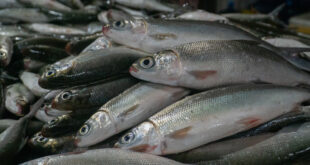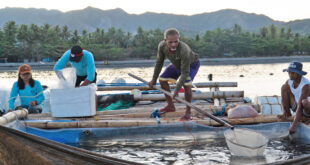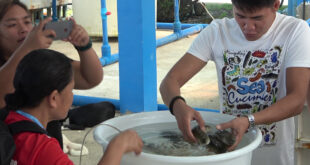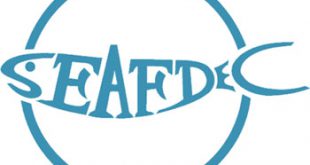 Technology Description
Technology Description
The technology of cage culture is relatively cheap and easy to run. The materials used in construction are indigenous and readily available like the bamboo supports. Filipinos are used to working with bamboo. In addition, grouper fry can now be produced in hatcheries or transported from areas where fry collection is an established industry, and there are a lot of places in the country where this is so.
Marine cage culture of grouper can be done in 4- to 12-compartment cage as one unit. There are nursery (small mesh is used in the cage) and grow-out phases (larger mesh). Grouper need to be sorted and size-graded every week. Other routine procedures include feeding (trash fish and/or formulated feeds), net maintenance, stock sampling, and monitoring water quality.
Groupers can reach the market-size of 400-600 g in 6-8 months when 2.5-7.5 cm fry are stocked. The live export market has the best price to offer.
| Technology profile: | |
 (1) Construct floating netcages, usually of size 5 x 5 x 3 m, and having 4 to 12 compartments. Attach floats (plastic drums, barrels) and sinkers or anchors (concrete blocks, etc). For the nursery cage, use a 0.5 to 1 cm mesh; for grow-out, use a 2-5 cm mesh. Place hides and shelters inside the netcage; these may be made of sawed bamboo tied in triangular bundles. (1) Construct floating netcages, usually of size 5 x 5 x 3 m, and having 4 to 12 compartments. Attach floats (plastic drums, barrels) and sinkers or anchors (concrete blocks, etc). For the nursery cage, use a 0.5 to 1 cm mesh; for grow-out, use a 2-5 cm mesh. Place hides and shelters inside the netcage; these may be made of sawed bamboo tied in triangular bundles.
(2) Stock wild- or hatchery-reared fry (2-10 cm length) in nursery cages at 100-200 per m3. Install hover-type lamp to attract copepods and other young fishes and crustaceans; these can be eaten by the grouper. But give added feed like mysid shrimps or finely chopped trash fish at 10% of fish biomass. Feeds are divided and given 2-4 times a day. If formulated feed is also used, go with the directions in the manufacturer ’s label. Do not overfeed; pollution can bring a fish kill. (3) Sort, size-grade, or thin out stock every week. Transfer same-sized grouper to the next vacant cage. When groupers are twice as big as initially stocked, they can be considered in the grow-out phase. (4) Do the same procedures as in the nursery: feed (reduced to 5% because large fish are over their growth spurt), size-grade and transfer, monitor water quality, change the nets at least once a month, sample the stock, and monitor fish for diseases and parasites. (5) Selectively harvest the 400-g or bigger groupers. Do not give feeds a day prior to harvest. |
|
References:
APEC / SEAFDEC Aquaculture Department. 2001. Husbandry and health management of grouper. Asia-Pacific Economic Cooperation, Singapore (APEC Publication No. 201-FS-03.1) and SEAFDEC Aquaculture Dept, Tigbauan, Iloilo. 94 p (In English, Filipino, Bahasa, Thai, Mandarin)
Baliao DD, de los Santos MA, Rodriguez EM, Ticar EM. 2000. Grouper culture in floating net cages. Aquaculture Extension Manual No. 29, SEAFDEC Aquaculture Department, Tigbauan, Iloilo. 10 p
Bombeo-Tuburan I, Coniza EB, Rodriguez EM, Agbayani RF. 2001. Culture and economics of wild grouper (Epinephelus coioides) using three feed types in ponds. Aquaculture 201:229-240
Bombeo-Tuburan I, Coniza EB, Rodriguez E. 2002. Preliminary report on nursery and grow out culture of hatchery-bred grouper (Epinephelus coioides Hamilton) in ponds. Aquaculture Research 33:379-381
Duray MN, Estudillo CB, Alpasan LG. 1997. Larval rearing of the grouper Epinephelus suillus under laboratory conditions. Aquaculture 150:63-76
Estudillo CB, Duray MN. 2003. Transport of hatchery reared and wild grouper larvae, Epinephelus sp. Aquaculture 219:279-290
Grouper culture. 1999. A 3-fold flyer downloadable from the SEAFDEC/AQD website www.seafdec.org.ph/publications_downloadable.html
Kohno H, Triño A, Gerochi D, Duray M. 1989. Effects of feeding frequency and amount of feeding on the growth of the grouper, Epinephelus malabaricus. The Philippine Journal of Science 118:89-100
Millamena OM, Golez NV. 2001. Evaluation of processed meat solubles as replacement for fish meal in diet for juvenile grouper Epinephelus coioides (Hamilton). Aquaculture Research 32 (Supplement 1): 281-287
Millamena OM. 2002. Replacement of fish meal by animal by-product meals in a practical diet for grow-out culture of grouper Epinephelus coioides. Aquaculture 204:75-84
Nagasawa K, Cruz-Lacierda ER, eds. 2004. Diseases of cultured groupers. SEAFDEC Aquaculture Department, Tigbauan, Iloilo. 81 p. (This is also available on CD format)
Pomeroy RS, Agbayani R, Duray M, Toledo J, Quinitio G. 2004. The financial feasibility of small-scale grouper aquaculture in the Philippines. Aquaculture Economics and Management 8:61-84
Tendencia EA, Fermin AC, de la Peña MR, Choresca CH Jr. 2006. Effect of Epinephelus coioides, Chanos chanos, and GIFT tilapia in polyculture with Penaeus monodon on the growth of the luminous bacteria. Aquaculture 253:48-56
Toledo JD, Nagai A, Javellana D. 1993. Successive spawning of grouper, Epinephelus suillus (Valenciennes), in a tank and a floating net cage. Aquaculture 115:361-367
Toledo JD, Golez MS, Doi M, Ohno A. 1999. Use of copepod nauplii during early feeding stage of grouper Epinephelus coioides. Fisheries Science 65:390-397
Toledo JD, Naret E, Nakagawa H. 2005. Comparison of fatty acid profile between cultured and wild-caught grouper, Epinephelus coioides. Aquaculture Science 53:127-134
 SEAFDEC/AQD Southeast Asian Fisheries Development Center | Aquaculture Department
SEAFDEC/AQD Southeast Asian Fisheries Development Center | Aquaculture Department



